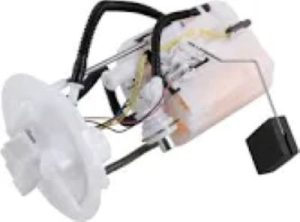Both inline and in-tank fuel pumps do the same job but also differ quite a lot in terms of location on the vehicle and how they perform. Inline fuel pumps, on the other hand, are mounted on the fuel line outside of the tank and tend to be used with high-performance or modified vehicles. This allows for easier access so you can change them out when they need servicing or replacement, and prices should fall between $100 through $300 depending on the brand and flow rate. Many tuners like inline pumps, as they can handle higher flow rates that come with more than 400 horses under the hood. In high-performance racing scenarios, inline pumps such as those from Kemso work tirelessly to deliver even fuel pressure during outrageous loads.
The in-tank fuel pump is, as the name suggests, located inside the fuel tank and sits partially or wholly submerged in fuel. This design works well to cool the pump during operation, which extends the efficiency and life of each component. While, in general, In-tank pumps have a lifespan of 100–200k miles when not overly strained by racing 🙂 Plunging into fuel further helps to prevent vapor lock, in which fuel boils before it can actually reach the injectors, a common problem at high temperatures. When it comes to production cars, in-tank pumps are now standard for most automotive manufacturers because they tend to be quieter and leave less risk of fuel starvation with the tank at low levels.
In-tank fuel pumps can generate an efficiency of more than 90% in comparison to some pumps, which merely work at around 60%. The pump itself stays cool as the fuel passes through it for lubrication. As versatile as inline pumps can be, the units mounted on the outside of the tank may lose efficiency in warmer applications depending on their environment and may garner heat build-up. In-tank systems are also quieter, typically under 50 dB compared to inline units that can exceed 70dB, especially in high-performance applications.

A common practice among aftermarket setups is to run both pumps (typically in a dual-stage configuration) with an in-tank pump feeding an inline pump for vehicles demanding massive amounts of fuel volume. Typical applications include high-horsepower drag race cars where power requirements routinely exceed the capacity of a single pump. The standard in-tank pumps generally range from 100LPH to 250LPH compared with the approximately 500 LPH that these inline pumps can handle in this configuration.
Like, why one over the other? It all comes down to what kind of power the vehicle needs and what it will be used for. Ideal for performance cars with frequent upgrades: Inline pumps are easier to reach and therefore simpler to maintain. Conversely, in-tank pumps are more durable and better choice for daily drivers where reliability and conservation of lifespan is desirable.
For further information on fuel pumps, such as various setups and specs of the different models, check out In-line Fuel Pump and please do not hesitate to contact us to learn more.